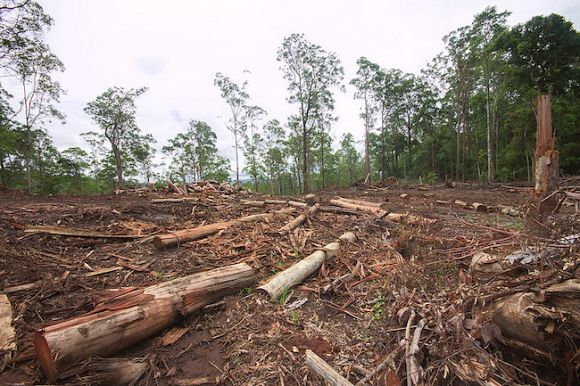Logging and bushfires have decimated giant gum trees in Tasmania. Unless we seriously tackle climate change, Australia stands to lose these biological treasures, writes Henry Johnston.
*This article is the monthly winner of the IA Writing Competition Most Compelling Article category.
I PASS A milestone this year. A pointer to a life fulfilled. A time of reckoning.
Somewhere it is written, humans are allotted threescore and ten years. As I think back on this gift, I recall the joys of my life on this planet as it spins in silence through the Milky Way.
Other non-human companions, whose life force makes my sweet time appear inconsequential, remind me of the fragility of existence.
I gazed upon them yesterday in Tasmania's Hartz Mountains down by Geeveston Town. But today, I learnt of a threat to companion trees, silent and majestic, in the far-off Mount Field National Park via Maydena, west of Hobart and towards the south from New Norfolk.
Both locales – the Hartz Mountains, bifurcated by the dark flowing Huon River and the Styx Tall Trees Conservation Area, watered by the gurgling Tyenna – bear the scars of two recent misfortunes.
The first threat, the ever-present menace of logging, elicits passionate arguments for and against, but recent disastrous fires seem forgotten, probably because of a convenient trick we humans employ to bypass certain certainties. If it is out of sight, so, it is out of mind. And I am told our home, the blue planet, experienced its hottest day since records began.
As I write, it is difficult to dismiss the vision of thousands of matchstick-like trees in the Hartz Mountains, bedecked in bright green epicormic growth.
At first, I assumed "all is well", but not so. In the wet mountain ranges of the southwest of Tasmania, trees grow to heights that my neck cannot tilt back to observe. Now, many exist as burnt relics of Gondwana Land, disfigured beyond recognition in a fragile environment utterly unprepared for fire.
As we chatted on the drive back to Geeveston, I recalled old black-and-white images I had seen of the Tunguska event, a cataclysmic explosion above Siberia on 30 June 1908.
On this day, an asteroid 50 to 60 metres in diameter disintegrated. Eighty million trees of the sub-Arctic taiga snapped backwards from a force felt across an event horizon covering 2,150 square kilometres. By comparison, Tasmania’s southwest wilderness is 4,500 square kilometres.
The harsh truth is this: the fires of 2018/19 demolished a biological treasure in an apocalypse every bit as astonishing as an exploding meteor.
But a silent disaster stalks these lifelong friends.
We humans are capable of creativity, both great and grave. Consider the ingenious Dutch: harnessers of wind energy since the 11th Century. Or Icelandic Vikings who, in the late 800s, used the thermal power of the bubbling hot springs of Thvottalaugur to bathe and wash their clothes.
And, of course, the Indigenous citizens of this continent, who for millennia mastered the art of "cool fires" as a means of tending the landscape.
Many white settlers, oblivious of the existence of Aboriginal Australians, likened this land to perfectly groomed parks. Convict artist Joseph Lycett, who lived in Australia from 1815 to 1822, painted remarkable depictions of the scenery of New South Wales and Tasmania. Lycett's artworks display rural landscapes reminiscent of the abovementioned parks.
Truth or a dream? Difficult to say, but what we know as fact is Aboriginal Australians employed fire as a tool to tend this land and water for its nourishment.
Scenes of clear-felling and desolate areas are not depicted in Lycett’s paintings or those of his contemporaries. Sadly, they are the reality of the landscapes we know and are, therefore, our inheritance. This blight diminishes these natural treasures.
Those who recall the plumes of smoke which sullied the pristine air above the southwest Tasmanian wilderness during those months of late 2018 and early 2019 – and above Dunalley in 2013 – now know these clouds by a sinister name: pyrocumulus.
Their official title is flammagenitus. Like the detonation above Tunguska, enormous columns of these dark pyrocumulus clouds could be seen from space. Even larger volumes of spent carbon entered the atmosphere above the Blue Mountains from the mainland fires of Christmas and New Year 2020.
In Greek mythology, Charon, the son of Erebus and Nyx (or night), toiled as the ferryman across the rivers Styx and Acheron. Charon accompanied the souls of the dead, honoured with the rites of burial. His payment was a coin placed in the corpse’s mouth.
Across the River Styx of the western part of Tasmania are gigantic gum trees, soaring 100 metres or more into the most pristine air on the blue planet. Are we to pay the ferryman?
Surely if our ancestors harnessed the energy of the elements of earth, water, fire and air, we too can develop sources of power which do not imperil the stuff of this precious life.
Henry Johnston is a full-time Australian author and essayist. You can follow Henry on Facebook here and on Instagram @harryjay1226. This article is the monthly winner of the IA Writing Competition Most Compelling Article category.
*Full IA Writing Competition details and conditions of entry HERE.
Related Articles
- POEM: Fossil fools
- La Niña could become the norm for Australia
- Mining moguls enjoy hot coal prices while global heating stuffs the nation
- Australia's debt to the world greater given our 'real' carbon emissions
- Lessons Australia can learn from UN's 'greenwashing' report
 This work is licensed under a Creative Commons Attribution-NonCommercial-NoDerivs 3.0 Australia License
This work is licensed under a Creative Commons Attribution-NonCommercial-NoDerivs 3.0 Australia License
Support independent journalism Subscribe to IA.














